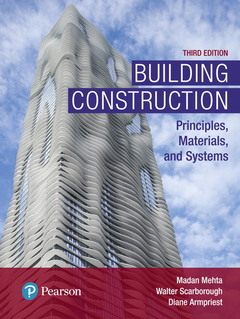Description
Building Construction (3rd Ed.)
Principles, Materials, and Systems
Authors: Mehta Madan, Scarborough Walter, Armpriest Diane
Language: English
Subject for Building Construction:
Approximative price 159.70 €
In Print (Delivery period: 12 days).
Add to cart1008 p. · 23.6x31 cm · Hardback
Description
/li>Contents
/li>Biography
/li>Comment
/li>
For one- or two-semester courses in Construction Methods and Materials and Design in Architecture.
Promoting comprehensive understanding in general and complex concepts in construction
Exceptionally well-received and one of the most acclaimed university-level books on construction, Building Construction, Principles, Materials and Systems is a comprehensive and fully illustrated introduction to construction methods and materials. It?s informed by a core philosophy that sufficient grounding in the principles and science of construction is the best way to equip today?s designers and constructors to respond successfully to rapid changes in the built environment. By ensuring students are well-versed in the science and technology of materials and systems, the text aims to better prepare architects, engineers, and constructors to produce a resilient and sustainable built environment?a need that will grow with increasing urbanization across the globe.
The science of building construction and design is evolving more quickly than ever before. The Third Edition of this outstanding text builds on the previous versions. It incorporates the latest updates available, features over one thousand new end-of-chapter problems, and now addresses common errors related to the topic. The organization of the text fosters a definitive understanding of general concepts before moving on to more complex concepts. Emphasizing a visual approach to learning, it includes original illustrations.
PART I: Principles of Construction
An Overview of the Building Delivery Process (How Buildings Come Into Being)
Design and Constructions Regulations
Loads on Buildings
Load Resistance (The Structural Properties of Materials)
Properties of the Envelope-I (Thermal Properties
Properties of the Envelope-II (Air and Water Vapor Control)
Fire and Smoke-Related Properties
Acoustical Properties of Materials
Principles of Joints And Sealants (Expansion and Contraction Control)
Principles of Sustainable Construction
Soils and Excavations
Below-Grade Construction (Foundation Systems and Basements)
PART II: Material and Systems of Constructions
Materials for Wood Construction-I (Lumber)
Materials for Wood Construction-II (Engineered Wood Products, Fasteners, and Connectors)
Wood Light-Frame Construction-I
Wood Light-Frame Construction-II
Structural Insulated Panel Construction
Material Steel and Steel Components
Structural Steel Construction
Cold-Formed Steel construction
Lime, Portland Cement, And Concrete
Concrete Construction-I (Formwork, Reinforcement, and Slabs-On-Ground)
Concrete Construction-II (Site-Cast And Precast Concrete Framing Systems)
Masonry Materials-I (Mortar and Brick)
Masonry Materials-II (Concrete Masonry Units, Natural Stone, and Glass Masonry Units)
Masonry and Concrete Bearing Wall Construction
Exterior Wall Cladding-I (Principles of Rainwater Infiltration Control)
Exterior Wall Cladding-II (Masonry, Precast Concrete, and GFRC)
Exterior Wall Cladding-III (Stucco, Adhered Veneer, Eifs, Natural Stone, and Insulated Metal Panels)
Glass, Glazing, and Light-Transmitting Plastics
Windows and Doors
Exterior Wall Cladding-IV (Wall System in Glass)
Roofing-I (Low-Slope Roofs)
Roofing-I (Steep Roofs)
Stairs
Floor Coverings
Ceilings
Appendix A: SI System and U.S. System of Units
Appendix B: Preliminary Sizing of Structural Members
Madan Mehta, B.Arch., M.Bdg.Sc., Ph.D., P.E., is a faculty member at the School of Architecture, University of Texas at Arlington, and teaches courses in construction and structures. He was previously the Director of the Architectural Engineering Program at King Fahd University, Saudi Arabia. A licensed professional engineer (Texas), Fellow of the Institute of Architects (India), and Member of the American Society of Civil Engineers, he has worked in India, Australia, the United Kingdom, Saudi Arabia, and the United States. With academic credentials in both architecture and engineering, he ran a comprehensive architecture/engineering practice while working as a faculty member at the Delhi School of Architecture, and he worked for a large general contractor in the United States during a leave of absence. He is the author of several full-length books and monographs on building construction, architectural structures, and architectural engineering.
Walter R. Scarborough, FCSI, SCIP, is Vice President and Regional Manager for Hall Building Information Group, LLC. He is a specifications consultant and registered architect (Texas) with over 35 years of comprehensive technical architectural experience in specifications, document production, and construction contract administration. Previously the Director of Specifications for 10 years for one of the largest architectural firms in the world, he was responsible for b
Organization and Approach
Full color diagrams feature throughout the text.
A unique organization creates an unparalleled exploration of building construction–principles of construction are covered in Part 1, and materials and systems of construction are covered in Part 2–providing students with a balanced learning approach.
A focus on principles in Part 1 emphasizes the basic principles common to the performance of most building materials. By doing this in the classroom, the authors have experienced that they can preclude or reduce repetition when progressing from one material or system to another later on in the course. This focus also encourages critical thinking and informed decision making related to building materials and methods of construction. These principles will sustain over time even as materials and systems/assemblies are bound to change.
The logical organization in Part 2 presents the materials and systems in an order based on the extent of their use in the working world.
Cornerstone coverage of sustainability features a comprehensive chapter on sustainability and thorough integration o




